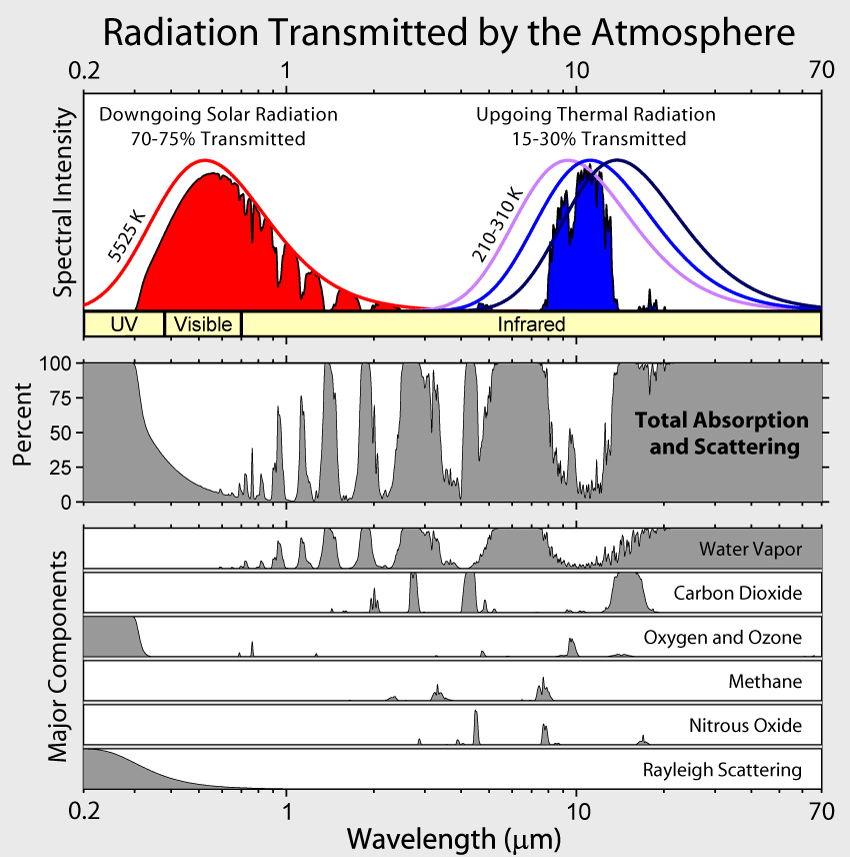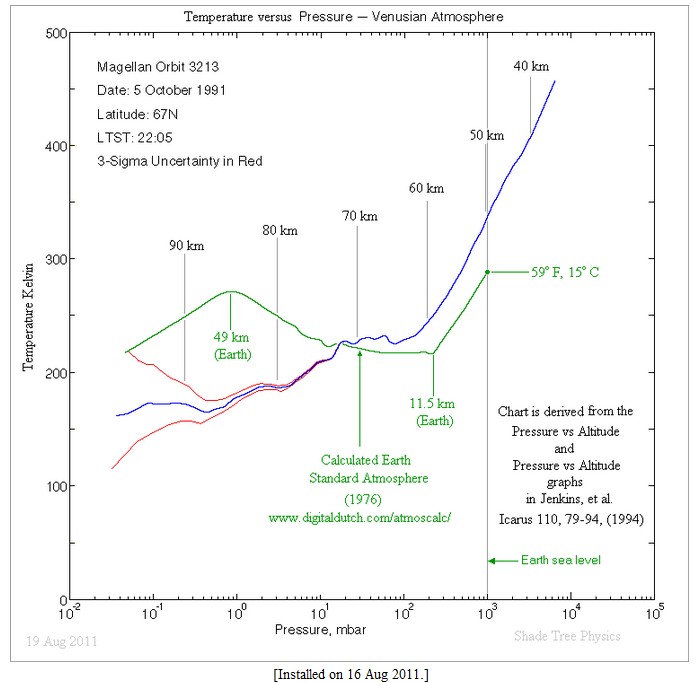Why is it hot on Venus?
Hansen started out his career with a dumb idea about Venus. His doctoral dissertation blamed the high temperatures on aerosols, which is pretty funny because now he blames low temperatures on aerosols. (Science was never his strong point.)
Later he admitted he was wrong, and instead latched on to Marijuana chain smoker Carl Sagan’s theory – the heat was caused by 95% CO2. Wrong again.
Venus is hot because it has a very thick troposphere. Atmospheric pressure on Venus is almost 100X higher than Earth. It is hot on Venus for the same reason it is hot in Death Valley and cold on Mount Everest.
If you traveled to Venus and descended into the atmosphere to an altitude of 50km, the atmospheric pressure and the temperature would be similar to that on Earth. This is in spite of the fact that the greenhouse effect at 1 bar on Earth is much stronger – because we have water vapor.
Compare the LW absorption of Earth’s atmosphere (Total Absorption and Scattering) to Venus atmosphere (Carbon Dioxide) at 1 bar, in the chart below. As you can see, the greenhouse effect on Earth is much stronger.
If you descended down to the surface, temperatures would rise about 8C per km – similar to Earth. The lapse rate is fixed, regardless of pressure broadening towards the surface, or whatever other dumb arguments people will bring up here.
Venus Atmosphere Temperature and Pressure Profiles
Venus is hot because it has a thick convective atmosphere. Falling air heats, and rising air cools. If the atmosphere on Earth were as thick as Venus, temperatures would be very hot here too.




This is a very simple matter and people of the future will be amazed to see how not everybody “got it” at the times of the IPCC.
Anyway…even raypierre’s book admits that in the troposphere, convection is much more important than radiation, so the radiative properties of CO2 are pretty much irrelevant. In fact, one doesn’t feel a surge of heat when clouds pass by, for example.
ps as an aside, the 1-bar height in the Cytherean atmosphere is a prime site for establishing a human colony http://en.wikipedia.org/wiki/Colonization_of_Venus#Aerostat_habitats_and_floating_cities
It is amazing how the leading atmospheric experts know almost nothing about the atmosphere.
@Omnologos: “In fact, one doesn’t feel a surge of heat when clouds pass by, for example.”
That’s because clouds (low clouds, anyway) are composed of droplets of liquid water, rather than water vapour. If a cloud was made of water vapour, you wouldn’t be able to see it. You can’t see through clouds due to scattering of light, caused by the water droplets:
“Light does often make it through clouds, but that light has just been scattered all over the place, making it nearly impossible to tell how the light was oriented before it entered the cloud. This is why we can’t see objects through clouds. The difference with radar is how much less it’s distorted while passing through a cloud.
The reason why clouds scatter visible light while leaving radar undistorted is a matter of relative scale. Radar’s longer wavelengths in effect average the properties of air with the properties and shapes of many individual water droplets, making the cloud look homogeneous – i.e. like moist air. Visible light has short enough wavelengths to respond to all the individual boundaries between air and water droplets. At each boundary the light is reflected to a new direction, and by the time it escapes the cloud, information on the light’s original direction is hopelessly lost. ”
http://envisat.esa.int/handbooks/asar/CNTR4.htm
I guess that explains the dark cloud. Since most of the cloud is very dark, and no light was lost, only scattered, one would expect brighter than average spots to go along with all the dark.
http://www.worldphoto.org/images/image/252305/?FromImageGalleryID=11808
Water vapor alone is an inhibitor of incoming TSI. A solar spectrum chart shows that about 98% of that energy lies between about 250 nm in the UV and 4.0 microns; with the remaining as 1% left over at each end. Such graphs often have superimposed on them the actual ground level (air Mass once) spectrum; that shows the amounts of that energy taken out by primarily O2, O3, and H2O, in the case of H2O which absorbs in the visible and near IR perhaps 20% of the total solar energy is capture by water VAPOR (clear sky) clouds are an additional loss over and above that.
Why is the atmosphere of Venus so dense? They don’t even have evil fossil fuels polluting their atmosphere.
I once wrote a post slapping a Cal Poly paper on Venus down. A commenter most of us veterans are familiar with, “Anything Is Possible” commented this….
I thought it insightful. And was going to repeat it, but, it didn’t seem right without giving AIP his props.
http://suyts.wordpress.com/2012/04/01/venus-and-her-layers-of-carbon-dioxide/#comment-7786
The Jenkins et al. graph on that link you provided is much easier to understand than the inverted graph shown in your post.
Carl Sagan may have been a pinko bed wetter but you are way off base criticising his analysis of the Venus surface temperature. He got it right while that anti-scientist (James Hansen) got it wrong. I can’t find the paper he wrote 40 years ago on the Internet but I remember it very well. This issue came up on Roy Spencer’s blog thanks to “Nullius in Verba”
http://www.drroyspencer.com/2012/03/slaying-the-slayers-with-the-alabama-two-step/#comment-38182
Over a year earlier on “Science of Doom” I spoke up in your support:
http://scienceofdoom.com/2010/06/12/venusian-mysteries/#comment-2953
At 1 bar in the Venutian atmosphere, RRTM shows that the greenhouse effect is about 30% of Earth. Yet the temperatures are a little higher on Venus than on Earth. It is the convection which controls the temperature, not the greenhouse effect.
Steve, I find the two pieces you wrote at WUWT about Venus and it’s atmosphere the most illuminating, lucid and, educational I have read. Points are sensibly made and succinct.
http://wattsupwiththat.com/2010/05/08/venus-envy/
http://wattsupwiththat.com/2010/05/06/hyperventilating-on-venus/
Unfortunately not all the graphic links work on these now.
It is not convection, but the fraction of the incident solar radiation that is directly absorbed by the troposphere, that controls the GLOBAL temperature level. Convection is just a weather phenomenon, not a global temperature determinant. The lapse rate rules over any and all other atmospheric conditions, and contrary to widespread scientific opinion, it does not depend upon convection–precisely because, as I have shown, the troposphere is warmed by direct absorption of incident solar IR, not from the surface. There is no greenhouse effect, of increasing atmospheric temperature with increasing carbon dioxide (you seem to think the greenhouse effect is just the absorption of infrared radiation by “greenhouse gases”, but you are missing the point that mere absorption of such radiation does not affect the lapse rate or the global temperature. And there is obviously water vapor in Venus’s atmosphere, just as there is in Earth’s atmosphere, as seen in the water-based clouds that exist there, in the same range of tropospheric pressures as on Earth. The Venus/Earth temperature ratio, at points of equal pressure over the Earth tropospheric range of pressures, is observedly due only to the ratio of the two planets’ distances from the Sun (no greenhouse effect upon the temperature, no clouds/albedo effect, no effect due to the nature of the planetary surface (Earth’s is 70% ocean, Venus’s, all solid crust). In both atmospheres, the same process (direct absorption of the same physical fraction of the incident solar radiation, most probably by the same atmospheric constituent: water vapor, at least over the range of Earth tropospheric pressures) warms both atmospheres, so that the Venus temperature is always just 17% higher than the corresponding Earth temperature, at a given pressure level in the aforementioned range of pressures–a ratio that is precisely due to Venus’s closer distance from the Sun, and nothing else. I wish you, and others, would stop confusing people with vague and incompetent ideas of just what is the “greenhouse effect”, and focus upon the effect being foisted upon the public, that it is an increase in global mean surface temperature due to an increase in atmpspheric carbon dioxide. There is no such effect.
Nice blog site.
And now we have a least two very reasonable arguments against Hansen’s tortuous Venus model, and thus against the whole AGW / climate change nonsense that has been built from this defective model.
– Einstein’s Constraint: “Everything should be kept as simple as possible, but no simpler.”
Einstein’s famous put-down: “The Good Lord may be subtle, but he is not malicious.”
To be clear: I haven’t said that “Convection is a global temperature determinant”. I have said that convection makes radiative properties of gases irrelevant in the troposphere.
One important thing to remember is that Venus ain’t just the “hot planet”. It has a long list of very peculiar characteristics, and they’re simply too strange to be unrelated. For example it rotates upside down very very slowly: the atmosphere rotates in the same direction as the surface but much faster (still, four times slower than Earth’s). The amount of energy that need be dissipated to get into such a situation is humongous. Also I wonder how much attrition heat is developed by the different rotational rates.
Venus has also a crater-free surface, perhaps as recent as 500M years old. The amount of heat needed to resurface it was, once again, hypergigantic.
Where has all that heat gone?
Fascinating stuff Steve. Thanks for this.
Why temperature at 50km is 340K, but if you search in other charts and also geoffrey landis works mention than at 50Km there is from 0C to 50Celcius?